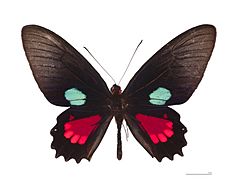Parides facts for kids
Quick facts for kids Parides |
|
|---|---|
 |
|
| Male Parides aeneas | |
| Scientific classification | |
| Kingdom: | |
| Phylum: | |
| Class: | |
| Order: | |
| Suborder: | |
| Infraorder: | |
| Superfamily: | |
| Family: | |
| Subfamily: | |
| Tribe: |
Troidini
|
| Genus: |
Parides
Hübner, 1819
|
Parides is a group of beautiful swallowtail butterflies. They belong to the family called Papilionidae. You can find these butterflies flying in North America, Central America, and South America. They are known for their bright colors and interesting patterns.
Contents
Discovering Parides Butterflies
Parides butterflies are a special type of swallowtail. They often have dark wings with bright spots or patches. These patches can be red, green, blue, or yellow. Their wings are usually quite large. This makes them easy to spot in their natural homes.
Where Parides Butterflies Live
These butterflies love warm places. They are mostly found in tropical and subtropical areas. This includes lush rainforests and other green habitats. They need plenty of flowers for nectar. They also need specific plants for their caterpillars to eat.
Habitats in the Americas
- North America: A few species live in parts of Mexico.
- Central America: Many different Parides species call this region home.
- South America: This is where most Parides butterflies live. They are common in the Amazon rainforest.
The Life Cycle of a Parides Butterfly
Like all butterflies, Parides butterflies go through a complete metamorphosis. This means they change a lot during their lives. It's a fascinating journey from egg to adult.
From Egg to Caterpillar
The life of a Parides butterfly starts as a tiny egg. The female butterfly lays her eggs on specific plants. These plants are called "host plants." Once the egg hatches, a small caterpillar (larva) comes out. The caterpillar's main job is to eat and grow. It eats the leaves of the host plant.
The Chrysalis Stage
After growing big enough, the caterpillar forms a chrysalis (pupa). This is a resting stage. Inside the chrysalis, amazing changes happen. The caterpillar's body transforms into a butterfly. This stage can last for weeks or months. It depends on the species and the weather.
Adult Butterfly Emergence
Finally, the adult Parides butterfly emerges from the chrysalis. It has beautiful wings and a long proboscis. The proboscis is like a straw. The butterfly uses it to drink nectar from flowers. Adult butterflies fly around. They find mates and lay eggs. This starts the life cycle all over again.
What Parides Butterflies Eat
Adult Parides butterflies drink nectar. Nectar is a sweet liquid found in flowers. It gives them energy to fly. Caterpillars have a different diet. They eat the leaves of specific plants. These plants often contain special chemicals. These chemicals can make the caterpillars taste bad to predators. This helps protect them.
Some Parides Species
Here are a few examples of Parides butterflies:
- Parides alopius Godman & Salvin, 1890 - White-dotted Cattleheart
- Parides childrenae Gray, 1832 - Green-celled Cattleheart
- Parides erithalion Boisduval, 1836 - Variable Cattleheart
- Parides montezuma Westwood, 1842 - Montezuma's Cattleheart
See also
 In Spanish: Parides para niños
In Spanish: Parides para niños

